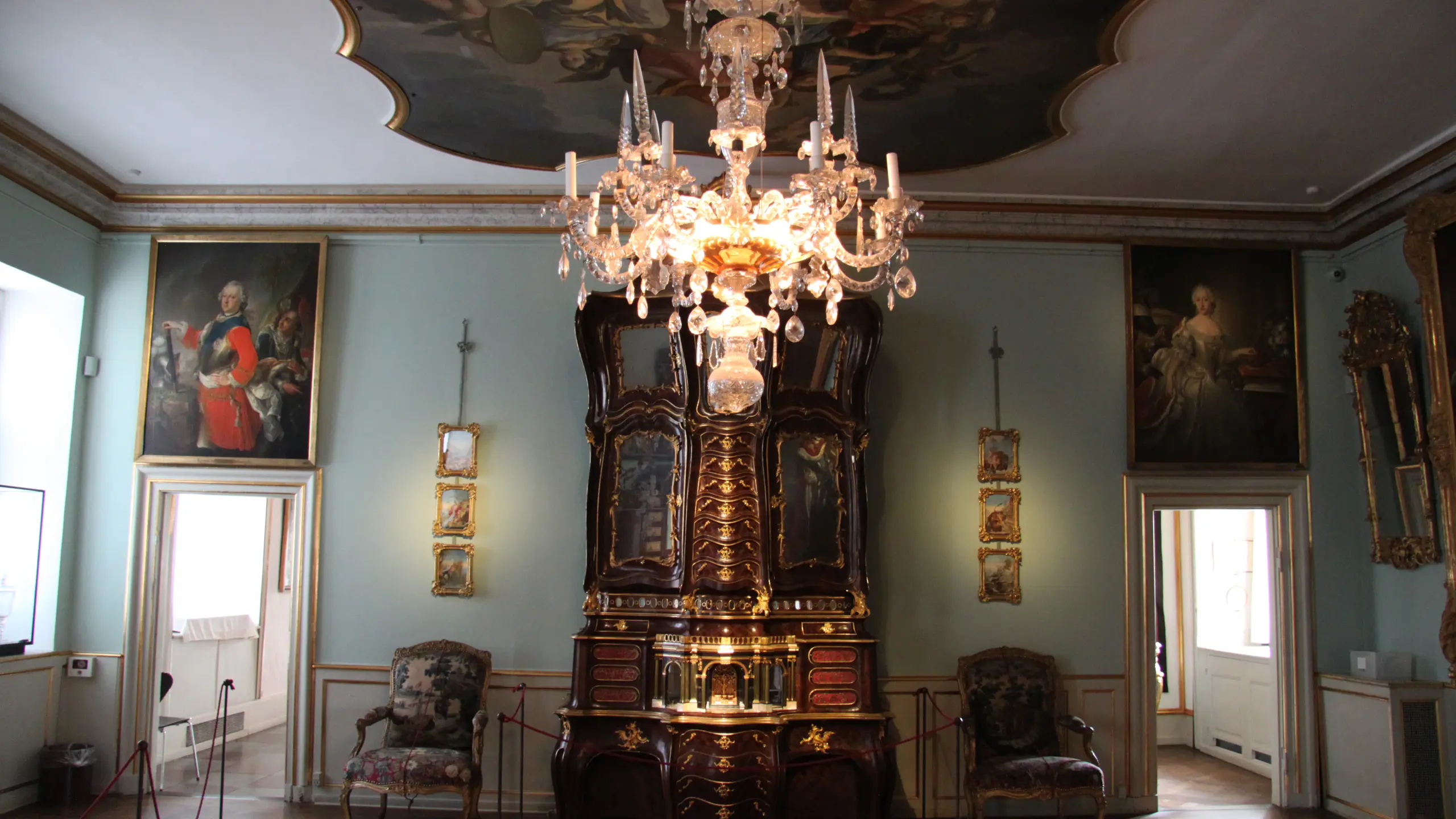The Rose (room 13)
When you enter the first room on the first floor of Rosenborg, you enter the Rose. Here, you can explore the beautiful paintings and unique objects, from the exceptional floor to the lavish music cabinet.

From dining hall to beautifully decorated antechamber
The name the Rose dates back to the time of Frederik IV, when this shared antechamber was used as a dining hall for the members of the royal household. The beautiful ceiling paintings were created by Frederik IV’s court painters, Bénoit le Coffre and Hendrik Krock. The paintings were originally part of the decoration at Frederiksberg Palace. But during the 19th century, both the ceiling paintings and the beautiful parquet floor were move here, from Frederiksberg Palace, and integrated into the decoration of this room. On the same occasion, the chandelier, which was made in England during the 18th century, was brought here from Jægerspris Castle. The reason why royal decorations and furnishings were brought to Rosenborg at this time was that, with the end of the absolute monarchy in Denmark during the mid-19th century, several castles and palaces became property of the state. At the same time, Rosenborg Castle was being converted into a museum, so it seemed obvious to add objects from these former royal palace and castles. Read more about this in the article about the development of Rosenborg Castle from royal residence to chronological collection.
The exhibited paintings, furniture and objects here in the Rose date from the time of Frederik V (1723–1766). During this period, rococo was the prevailing style in European art and decorative art, which is reflected in many of the beautiful pieces in here – for example this four-metre-tall music cabinet created by C. F. Lehmann.
Objects in the room
If you are physically at the museum, you can admire the outstanding objects and read more about them below.
Please note that these descriptions are brief and often without images. They serve as an additional resource for those who wish to gain more knowledge about each object, such as who created them, their origin, and significance.
-
1301Portrait of Frederik V as a young man, painted by J.S. du Wahl.
-
1302Portrait of Frederik V as a young man, painted by J.S. du Wahl.
-
1303Portrait of Princess Louise, sister of Frederik V; by unknown artist.
-
1305Cabinet in walnut veneer with inlays of landscapes in semi-precious stones. Made in c. 1740 for Hirschholm Palace.
-
1306Models of two naval ships and of Rosenborg. Made in tortoiseshell, mother-of-pearl, bone, amber and hair, by customs officer Niels Nielsen in Ålborg in the 1750s.
-
1307Three dice on a tortoiseshell foot, turned by Lorenz Spengler.
-
1308Cup with tortoiseshell egg, made by Lorenz Spengler for Frederik V’s private collection in Christiansborg Palace, 1764.
-
1309Cups of ivory, rhinoceros tusk, tortoiseshell, calabash and antler. Made by Lorenz Spengler for Frederik V’s private collection in Christiansborg Palace, 1750-57.
-
1310Hercules saving Deianeira from the centaur Nessus. Figure-group of ivory, signed J(ohann) E(phraim B(auert), made for Frederik V, 1756.
-
1311Sophie Magdalene, painted by J.S. du Wahl.
-
1312Ostrich egg with censer and lidded cup of ivory and amber, turned by Prince Wilhelm of Hesse, 1760-65.
-
1313Gilt carved console table with Norwegian marble top. Made for the crown princess’s audience room in the Prince’s Palace in 1745-46.
-
1314Small portrait of Frederik V on horseback, painted by C.G. Pilo.
-
1315Prince Frederik. Small full length painting by J.G. Ziesenis 1767.
-
1316Two carved, gilded armchairs marked "C6" and "KSCB 1740", i.e. from the Royal Palace of Christiansborg, which was inaugurated in 1740.
-
1317Frederik V. Painted terra cotta relief by L. von Lücke. c. 1753.
-
1318Rosewood cabinet with inlays of coloured bone, mother of pearl, and metal. In the drawer a spinette. Made in Copenhagen 1755 by C.F. Lehmann.
-
1319Margrave Friedrich Ernst of Brandenburg Baireuth (1703-62); Queen Sophie Magdalene's brother, Governor of Schleswig and Holstein, Danish Field Marshal, Lieutenant General. Small three quarter portrait on copper, signed: J.F. Gerhard fec.
-
1320Queen Louise, full length, painted by C.G. Pilo.
-
1321Cups of nautilus shell and semi-precious stones, set in mother-of-pearl by Lorenz Spengler for Frederik V’s private collection in Christiansborg Palace, 1750.
-
1322Gilded, carved console table with top of black marble. Marked "C6" and "KSCB", i. e. from Christiansborg Palace, which was inaugurated in 1740.
-
1323Christian VI, painted by J.S. du Wahl.
-
1324Portrait of Frederik V as a young man; painted by J.S. du Wahl.
-
1325"Science and Art Paying Homage to Frederik V". Sketch signed: Peder Als inv. et pinx.
-
1326Casket of tortoiseshell with inlays of mother-of-pearl and ivory, depicting a Norwegian mine and other motifs. Copenhagen, c. 1760.
-
1327Walnut commode with gilt carving. Copenhagen, c. 1740. Possibly made by Matthias Orthmann.
-
1328Christian VI, full length portrait painted by J.S. du Wahl. Gift from the King to General Grüner, who was Ambassador in Stockholm, 1740-43 (pendant to no. 1330).
-
1329Frederik V. Equestrian picture; allegorical representation, signed: J.F. Gerhard 1747.
-
1330Frederik V as Crown Prince; full length portrait painted by J.S. du Wahl, 1740 (pendant to no. 1328).
-
1333Princess Louise, Frederik V's sister (1726-56). Duchess of Saxe Hildburghausen. Three quarter portrait, signed: T. Huber.
-
1340Walnut cabinet with flute-work and music cylinder. Made by C.F. Lehmann in Copenhagen, finished 1757.
-
1346Duke Ernst Friedrich Carl of Saxe-Hildburghausen (1727-80), brother-in-law of Frederik V. Three-quarter portrait, signed: T. Huber 1751.
-
1351Crown cup from the Norwegian glass factory at Nøstetangen. Richly engraved with Frederik V's monogram. Signed: H.G. Köhler 1752.
-
1354Crown cup of Norwegian glass, with the monogram of Christian VII and Caroline Mathilde, and the date MDCCLXVI, 8th (Nov., i. e. the wedding day). Engraved by H.G. Köhler.
-
1356White clock, with carved gilded Rococo ornaments, and flute-work. Signed: I.P. Adamy in Stettin.